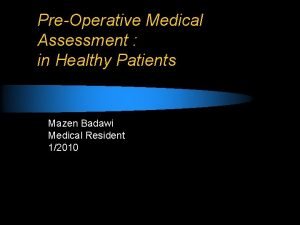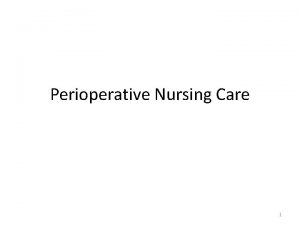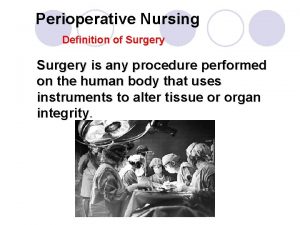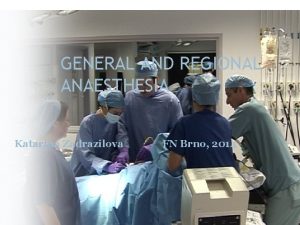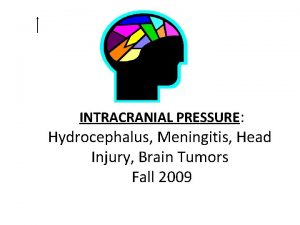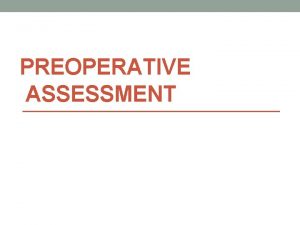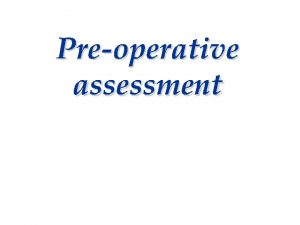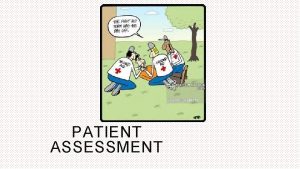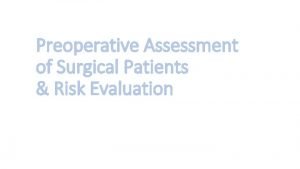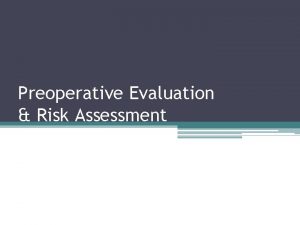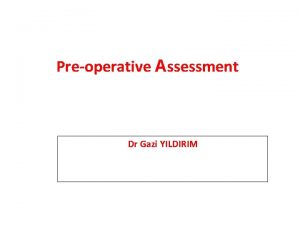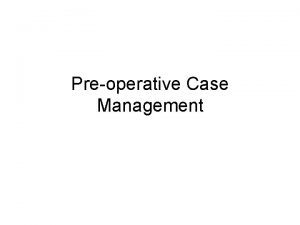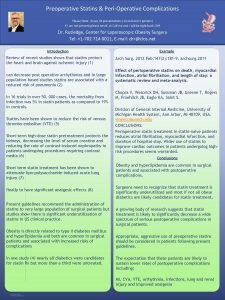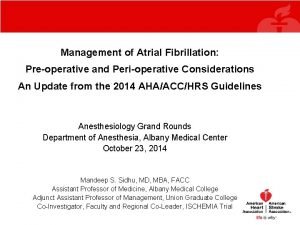Perioperative Division New Employee Orientation Preoperative Patient Assessment


























- Slides: 26

Perioperative Division New Employee Orientation Preoperative Patient Assessment & Care Planning

The Preoperative Assessment n n Part of the perioperative nurse’s responsibility is to collect and organize data to formulate a nursing plan of care in order to promote desired outcomes for the surgical patient Assessment includes: n n Verification of patient identity Verification of the planned surgical procedure(s) Gathering data on the patient’s physiological health Gathering data on the patient’s psychosocial health

Verifying Patient Identification n Verify the surgical patient’s identity with the ID band chart, in addition to verbally verifying identity with patient n Ask patient for active verification- it is better to ask open-ended questions such as “please tell me your full name”, rather than yes-no questions, i. e. “are you Matt Damon? ”

Verifying the Planned Procedure(s) n Verify the planned procedure(s) & informed consent with the patient or representative, including patient’s understanding of planned surgical procedure & the intended surgical site n It is best to use open-ended questions rather than “yes – no” questions, as an anxious patient might just answer “yes” without really hearing the question n If patient’s understanding of the procedure does not align with the patients informed consent contact the surgeon for clarification

Informed Consent

Informed Consent must be Obtained for: n n For any surgical procedure Endoscopy Procedures Placement of vascular lines (PICC, arterial line, central line, etc) Transfusion of blood products See UAB Hospital Interdisciplinary Standard Informed Consent for full list of procedures requiring an informed consent

Special Consent Forms are Required for: n n n n Investigational procedures Use of investigational devices Organ donation Dialysis (either hemo- or peritoneal dialysis) Refusal of treatment Disposition of body or organs after death Autopsy

What is the Significance of the Informed Consent? n Informed consent means that the surgeon (or designee) has discussed potential risks, benefits and alternatives to the planned surgical procedure(s), and the risks/benefits of forgoing treatment to the patient and/or their representative n Consent must designate surgical site(s), including any left/right distinction

Who can give Consent for a Surgical Procedure? n n A competent adult patient over 19 years of age In cases where the patient is a minor or not considered to be mentally competent consent must be obtained from the patient’s representative who may be: n n n a competent adult who is the patient’s next-of-kin the patient’s legal guardian an adult who has legal power of attorney to make decisions for the patient

Nurses’ Role in Informed Consent n A nurse can witness the patient’s signature on the consent form, but only the surgeon can obtain the patient’s consent for the surgical procedure n The surgeon may obtain the patient’s consent prior to hospital admission & include an order for the consent in the admission orders – in this instance a nurse can complete the consent form. n In the absence of a licensed nurse any competent adult can serve as a witness

Legal Issues with Consents n Age of consent in the State of Alabama is 19 and older, UNLESS a minor is: n n 14 years of age or older and is/has been married/divorced/pregnant and/or has graduated from high school Failure to obtain informed consent when necessary can be legally considered battery

How Long is the Consent Form Considered to be Valid? n Signed consents are valid for the duration of a patient’s hospital stay

Consent in Emergency Situations n A physician may provide treatment in an emergency situation without an informed consent if: n n immediate treatment is required to preserve life or prevent serious impairment, and -the patient is unable to give consent & a representative of the patient is not available

Telephone Consent n n In emergent situations where the patient is unable to give consent a physician can obtain telephone consent from the patient’s next-of-kin or legal guardian A competent adult can witness phone consent When telephone consent must be obtained a UAB Call Center operator can establish a three-way call Physician must document: n n n Why treatment is urgent Why the patient is unable to give consent Name of person (relative or other) giving consent

Emergency Situations n If treatment is urgently needed and: n n n The patient is unable to give consent The patient has no known relatives or legal guardian Treatment may proceed provided that two physicians agree and document that immediate treatment is necessary & that attempts to contact a guardian for the patient were unsuccessful

Patient Assessment & Care Planning

Planning Patient Care n n Assessment Planning Care Implementation Evaluation of effectiveness of care

Physiological Health n Assess the patient’s: n n n Allergy status Condition of skin Physical mobility Any sensory impairments Status of major systems: cardiovascular, respiratory, renal Overall health status, including nutritional status

Physiological Health n Assess: n n n Relevant Lab data (Including HCG on all women of childbearing age/capability) Documentation – H&P Availability of blood, if indicated Presence of indwelling devices, either permanent implant or temporary devices (Foley catheters, NG tubes, external pacemakers, etc) Any history of problems with previous surgeries/anesthesia

Psychosocial Health n Assess: n n Patient’s understanding of the planned surgical procedure Patient’s anxiety level and coping mechanisms Any special needs the patient may have: emotional, cultural, spiritual Support system-does patient have family waiting?

Assess Patient for: n n NPO status “Anything Removable”- dentures, partials, jewelry (including body jewelry!), contact lenses, etc

How Many Times Am I Going to Be Asked the Same Questions? n n Surgical patients sometimes find being asked the same questions repeatedly irritating. Reassure patient that repeated questioning is for their safety

Perioperative Nursing Care Planning n n Use information gained from assessment to plan care Does patient have any special needs? (Example: patient with deformities caused by Rheumatoid Arthritis may have special positioning needs; patient who does not speak English will need an interpreter) Communicate any special needs or concerns the patient has with other members of the surgical team

Implementation n n Carry out plan of care Be flexible—changes in procedure or patient condition might change plan of care

Evaluation n Reassess the patient at completion of procedure Were the desired outcomes met for this patient? If not, why? Use this information for quality/process improvement n Example: a patient is found to have a reddened area over calcaneus at completion of procedure. Reassess how patient’s heels were padded – how can this be done better next time?

References n n Roth (1994) Perioperative Nursing Core Curriculum Rothrock (2003) Alexander’s Care of the Patient in Surgery
 Perioperative care phases
Perioperative care phases Cataract nursing diagnosis
Cataract nursing diagnosis Preoperative medical evaluation of the healthy patient
Preoperative medical evaluation of the healthy patient Preoperative patient education ppt
Preoperative patient education ppt Nih new employee orientation
Nih new employee orientation Fsu new employee orientation
Fsu new employee orientation New employee orientation
New employee orientation Employee attitudes and employee performance
Employee attitudes and employee performance Employee safety orientation quiz answers
Employee safety orientation quiz answers Feldman's stage model of socialization
Feldman's stage model of socialization Patient 2 patient
Patient 2 patient Dicom tag list
Dicom tag list Ethnocentric orientation adalah
Ethnocentric orientation adalah Definition of perioperative
Definition of perioperative Perioperative nursing case study
Perioperative nursing case study Ccs perioperative guidelines
Ccs perioperative guidelines Site:slidetodoc.com
Site:slidetodoc.com Nursing management preoperative care
Nursing management preoperative care Preoperative care ppt
Preoperative care ppt Nursing management of glaucoma
Nursing management of glaucoma Cushings reflex
Cushings reflex Rula employee assessment worksheet
Rula employee assessment worksheet Employee threat assessment
Employee threat assessment 369 times 2
369 times 2 Sunthetic division
Sunthetic division Terms of division
Terms of division How to divide polynomials using long division
How to divide polynomials using long division


